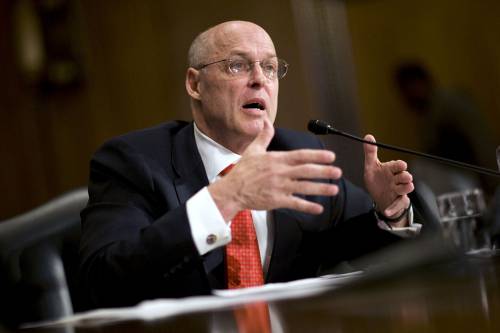The Ugly Politics of Financial Bailouts
When an economic bailout gets political, all bets are off. Look what happened when the German banking system melted down during the Weimar Republic in 1931.
Jul 31, 20202.5K Shares644K Views
Secretary of the Treasury Hank Paulson (WDCpix)
The $700-billion financial-reconstruction package passed by Congress and signed into law last week is a key element in the stabilization of the U.S. financial crisis. But it has become a tremendous political problem. As have similar programs proposed in Ireland and Germany to deal with the increasingly dire state of European banks, many of which have substantial cross-border interests and activities.
These plans are all discussed in emotive terms: not a relief program, but a bailout. At stake are not troubled assets, but toxic assets. The transformation of financial tonic into a political toxin recalls not the well-managed Scandinavian rescue operations of the 1990s but some of the most tumultuous scenes from bank rescues in Europe in the 1930s.
Illustration by: Matt Mahurin
The current U.S. package has clearly become a captive of the the presidential and the congressional elections.
Had they signed on to the original plan of the Bush administration, which they were campaigning against, Democrats would have discredited their claim that the administration helped create the country’s financial crisis. So they needed to add measures to the plan that would give it a different look–and then trumpet it as a Democratic achievement. That’s precisely what House Speaker Nancy Pelosi (D-Calif.) did in introducing the bill Sept. 29.
On the other side, Republicans had a tough time accepting the massive government intervention that would be put into motion by the reconstruction package. Their fervor was fanned by the law’s overwhelming unpopularity among the public.
The result: The initial bill went down to defeat on what turned out to be Congress’ Black Monday.
This transformation of a financial tonic into a political toxin is not new.
President Herbert Hoover’s Reconstruction Finance Corp. of 1932 is now widely touted as a model for a government-support mechanism. It lent money to state and local governments, as well as to businesses, farms and banks, when other sources of financing had dried up. But it quickly became obvious that the money’s distribution was a payback to supporters of the government. The scheme became a huge political kickball.
During the Great Depression in Europe, financial bailouts were far larger and had far more disturbing consequences.
Chancellor Heinrich Bruening presided over Germany's bailout in 1931. (Wikimedia)
Faced by a complete meltdown of the German banking system in the summer of 1931, the government of the Weimar Republic acted swiftly to manage the crisis. In retrospect, the strategy looks quite innovative. Indeed, many of its ideas echo those put forth just last week to relieve the current financial crisis in the U.S.
Here’s what the German government did.
First, it reorganized the banks, merging the country’s two weakest banks and injected public money into all of them. Initially, the government had sought private financial help as well; there were intense negotiations with the leading figures of the powerful Rhine-Ruhr steel lobby.
But the country’s business leaders agreed to participate in the rescue plan only if the Weimar government kicked in more public funds and advanced them the money that they were supposed to invest in the recapitalization of the banks. Before Adolf Hitler came to power in 1932, the public owned large stakes in Germany’s banks.
Second, the central bank pushed for the creation of an institution that would allow it to discount bills from banks that could not be traded because the interbank market had stopped operating.
Finally, in December 1932, the government created a “bad bank,” to use Wall Street’s coinage, to take on its books all the financial system’s troubled assets that had no market and whose price was far below their par value. To secure the help of the “bad bank,” financial institutions had to show that “important economic interests” were at stake and that state funds had been used to support strategically vital enterprises.
The Weimar government’s financial rescue package opened the way for a huge — and hugely unpopular — bailout of Flick steel on Chancellor Heinrich Brüning’s last day in office.
And, politically, it led to the charge that the government was engaging in the “socialization of losses” to benefit a privileged elite, a charge that became a central element of the turbulent electoral campaigns of 1932.
A similar–though more expensive and extensive–bailout in Austria produced equally crippling effects. The collapse of the Creditanstalt in May 1931 triggered the wider financial collapse in Europe, and the government’s answer was to take over the bank and eventually merge it with other weakened Austrian banks.
The government subsidy amounted to 9 percent to 10 percent of Austria’s gross national product, an amount comparable to the projected costs of the U.S. government’s bailout of the financial system. Because the Creditanstalt held major stakes in most large Austrian firms, the government’s takeover of the bank meant that it was, in effect, running most of Austria’s businesses.
The bailout was accompanied by massive corruption, the revelation of which became the stock-in-trade of the opposition Nazi movement in Austria.
The political costs of these bailouts — even when they seemed to have been implemented promptly and with high efficiency, as in the German case — exceeded the simple fiscal arithmetic. They injected the state into micro-level decision-making–on the health of particular enterprises and on the fate of individual bank directors, for example–that was bound to be contentious.
But there was a far more dangerous consequence of the German and Austrian governments’ responses to their respective banking crises: They fanned the poisonous ideological anti-Semitism then current in 1930s Central Europe. In Germany and, more explicitly, in Austria, “aryanization,” first called “Germanization” or “Austrianization,” had set in even before the Nazis took power in the two countries, and they bailouts played right into it.
In retrospect, Germany’s and Austria’s attempts to manage bank failures look like the catalyst of state domination, corruption and even racial persecution that would combine to form an ever more menacing force in the world.
There is a clear policy lesson to be gleaned from this terrible and extreme history.
First, financial bailouts need to be depoliticized as much as possible.
Second, this can best be achieved by formulating financial relief packages in general terms — such as raising the amount of bank deposits covered by the Federal Deposit Insurance Corp. — and not as assistance targeted to specific institutions that are politically or economically sensitive.
We should also remember that, however hard the contours of the bailout are in a national political context, the difficulties are greatly magnified when they relate cross borders. For this reason, an American rescue is a piece of cake compared to a European one.
Harold James, a professor of history and international affairs at Princeton University, is the author of “The German Slump: Politics and Economics 1924-1936? and “The Nazi Dictatorship and the Deutsche Bank”

Hajra Shannon
Reviewer
Latest Articles
Popular Articles


